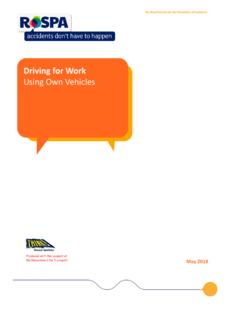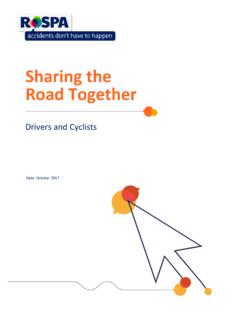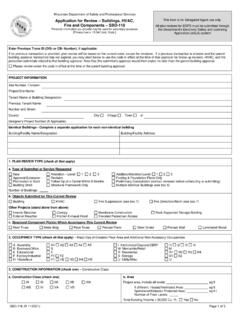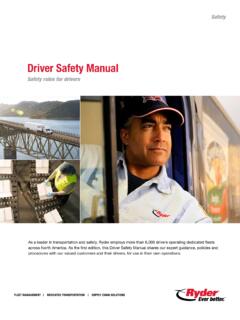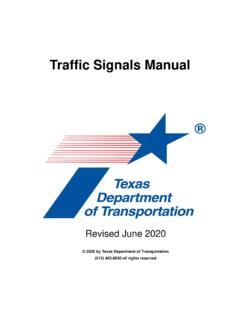Transcription of School Site Road Safety - RoSPA
1 The Royal Society for the Prevention of Accidentsaccidents don t have to happenSchool Site Road SafetyContentsIntroduction 3 How to use this guide 7 Plan 6 Do 8 Check 10 Act 11 Assessing and managing risk 12 The law 22 References 25 Appendices 262 School Site Road SafetyIntroductionOne of the most frequently expressed road Safety concerns is that of the Safety of children outside schools. At School drop-off and pick-up times, the roads in the immediate vicinity of schools are especially busy and there is usually a high level of vehicle, pedestrian , and cyclist activity.
2 This causes congestion and very often leads to frustration from residents and motorists at the apparent chaos caused by parents and children arriving or leaving the School . Although relatively few incidents occur on or near the School site, it is important that School leaders have taken all reasonable steps to avoid them. The School would need to demonstrate that they have adequate risk assessments should anything unfortunate happen on or surrounding the School leaders must assess the risk from vehicle movements on their premises and manage those risks in line with current workplace transport guidance from the Health and Safety Executive (HSE). School leaders should also consider in their risk assessment vehicle movements occurring immediately outside the School premises, which may be associated with School activities, such as staff arriving and leaving work, delivery vehicles, School buses transporting pupils and parents collecting and dropping off guide has been written as a reference manual for School leaders who are responsible for School site Safety .
3 It provides advice and information on how to minimise risks children face when walking on the School site and immediately outside the School on the public highway. It also provides guidance material to assist you in assessing School certain points we use case studies to illustrate examples to help you to begin to evaluate the movement of traffic and pedestrians in and around your School site. This will allow you to think about how you can implement your own policies to achieve acceptable levels of risk control solutions that comply with your legal and moral is intended as an overview. RoSPA has more detailed guidance on its Schools & Colleges website , including specific information on School visits. We also have a range of services that we offer to schools and colleges. You may wish to contact our helpline for some initial help and advice on (0121) 248 2235 or We recognise that schools need to work with other responsible bodies to ensure the Safety of traffic and pedestrians outside the School grounds.
4 These bodies include police, local authorities, schools and Site Road SafetyThe number of road traffic accidents that occur on roads in the vicinity of 1 IN 3of all child pedestrians that are killed or seriously injured (KSI) are aged 10 11 years old. ALMOST HALF of all accidents that happen on the road occur between 15:00 and 18 MONTH1,200 children are injured in traffic related collisions that happen within 500m of a TO 15 YEAR-OLD BOYS are nine times more likely to be in an accident when riding a bike than a girl of the same QUARTER of road traffic casualties are 13 to 15 risk: how safe are our children?Despite the fact that the UK has some of the safest roads in the world,1 thousands of children are injured on our roads every year, making road traffic accidents a significant cause of premature child death.
5 Despite a significant reduction in annual child casualties since the 1970s, the figures have mostly plateaued over the last decade. Child pedestrian road risk increases as children become more independent (from aged 10 upwards), with most child casualties occurring between the School run hours, namely 8:00 9:00 and 15:00 16 This is due to this age group being more likely to move around unaccompanied by adults, and also having cognitive and physical limitations that make them more vulnerable in road traffic than Site Road SafetyThis guide follows the Plan, Do, Check, Act (PDCA) approach. It is important to recognise the cyclical nature of PDCA, and that it will require the organisation to adjust, refine and in some instances revisit previous steps and actions, if it is to be truly section in this guide presents a number of questions and aids for the School leader to review and develop.
6 In Appendix 1 we have provided a self-review tool which can be used at an early point to better understand your School s current road Safety position. Appendices 2, 3, 4 and 5 can help your organisation through the risk assessment process. How to use this guideSchool leaders to set the policy and plan for effective health and Safety management Does the School have a separate policy for pedestrian and traffic management? Is it led by a named person, headteacher, governor, executive headteacher? Does the School understand the scope of its responsibility?Reviewing your performance and learning lessons Can you improve? Is something not working? Learn from your experience and take action Has any activity taken place in the last year to improve road Safety and access to the School site? Have risks been acted upon and have relevant organisations been contacted if risks were identified?
7 Monitoring and reporting Measure your performance Can the School demonstrate that it has adequately controlled the significant risks?Risk profiling, organising, implementing your plan Identify the risk profile Organising Is there an agreed delivery plan in place? Implement your DO CHECK ACTPDCAAPPROACH55 School Site Road SafetyPlanning and organisingPLANIn addition to a School /STARS travel plan, does the School have a separate policy for pedestrian and traffic management?Developing a separate vehicle and pedestrian management policy may be useful for your School site; this will ultimately depend on the size of School , the location and specific site issues that you have. Other schools will set out their policy within their overall site Safety policy and then have a risk assessment specific to vehicle and pedestrian policy should reflect findings and decisions from both the incident analysis and risk assessment, and ensure that the objectives can be adequately resourced and are realistic to the School manages its own site Safety , it may also have some responsibility for the traffic it generatesii.
8 You may need to reflect and include in your policy how you will engage with the various organisations responsible for road use outside the School gate. These include: police, the local authority highways department or sustainable travel team, and Highways create an effective policy, consultation with both internal stakeholders and the wider community is it led by a named person?Employers (such as Local authorities) have ultimate responsibility for health and Safety in a School . The employer delegates the role of designing health and Safety procedures, policies and day-to-day management to the leadership within the School , and it is the School leaders who set the direction for effective health and Safety must appoint a competent person to ensure they meet their health and Safety duties, and have a person responsible for implementing the schools transport policy.
9 A competent person is someone with the necessary skills, knowledge and experience to give sensible guidance about managing the health and Safety risks at the can be someone appointed directly by the School , one or more of its staff, or the employer can arrange support from outside the School . In most schools, the senior leadership team can manage Schools should set out their policy in three sections:Part 1: Statement of intent State your general policy on health and Safety at work, including your commitment to managing health and Safety and your aims. As a School leader you should sign it and review it 2: Responsibilities List the names, positions and roles of the people in your School who have specific responsibility for health and 3: Arrangements Give details of the practical arrangements you have in place, showing how you will achieve your health and Safety policy aims.
10 This could include, for example, doing a risk assessment, training employees and using Safety signs or ,8 The risk assessment must cover the risks to the health and Safety of employees and of people (including pupils) who are not employees of the School . Schools are obliged to record significant findings of the assessment. Does the School understand the scope of its responsibility?Under the Health and Safety at Work Act, schools have a legal obligation to ensure that their site is as safe as reasonably possible. The following two questions are important for a School to answer, especially when dealing with School -generated traffic surrounding the School site. Is it my organisation s responsibility to manage this risk? Will the risk affect my staff, pupils or visitors?ii Ideally the School should an aim to try and reduce this and encourage sustainable modes of transport such as walking, cycling and scooting by both parents and families and School staff Site Road Safety Clearly identify the issues and scope that you want the policy to address Identify any policies and guidance that are already established, and assess if these may conflict or link with the proposed policy Identify and nominate the person(s)





